Acetabulum Fractures: Mechanism of Injury, Demographic Features and Associated Injuries
Introduction
The acetabulum is a cup shaped depression on the outer surface of the hip bone and it articulates with the head of the femur. Acetabular fractures occur when the head of femur is pushed into the pelvis by a lateral blow to the hip or by an anterior blow to the knee with hip in flexion and abduction [1]. Acetabulum fracture has rare incidence of about 5/100,000 people per year, as compared to proximal femur fractures, which has about a hundred times higher incidence, based on geographical areas [2]. However, this rate is on the rise worldwide as a result of increase in road traffic accidents and high impact injuries1.About 80% of acetabular fractures result from high energy trauma like in road traffic accidents and around10.7% result from fall from a significant height [3]. Acetabulum fracture present more often in multiple trauma patient and are considered as serious injury [3]. Patients present to emergency department with history of pain or a hip deformity, usually with other associated injuries such as hip dislocation, femoral neck fracture or sciatic nerve palsy. They can also present with trauma to the surrounding structures like peri-pelvic soft tissues, extremity fractures, trauma to major abdominal viscera and chest injuries [4]. Pelvic insults can be diverse, ranging from minor lacerations to major debilitating complex acetabular fractures [4]. Different factors are associated with mortality and morbidity of patient including mechanism and the energy of initial insult, age, male gender, cardiac diseases, dementia, institutionalization and rehabilitation. That should be carried out after hip trauma and plays a significant role in patient recovery [5-7].
In general, operative treatment of an acetabular fracture should not be performed as an emergency except when it is a part of open fracture management or is performed for a fracture associated with an irreducible dislocation of the hip. In such cases, the top priority would be resuscitation followed by Advanced Trauma Life Support protocols [8]. The aim of our study is to assess the pattern of acetabulum fractures presenting to our unit and the injuries they are associated with in relation to the initial mechanism and severity of trauma.
Methods
This study is a case series for which data was collected from the Department of Orthopedics & Spine Surgery Hayatabad Medical Complex Peshawar. Patients who met the inclusion criteria from January 2015 to December 2020 were selected. The inclusion criteria consisted of adult patients with traumatic acetabular fracture. The exclusion criteria included pediatric patient with traumatic acetabular fracture, pathologic acetabulum fracture, periprosthetic acetabulum fracture and patients who were previously operated on the same hip joint. All patients were admitted under the care of consultant orthopedic surgeon and were operated on a dedicated list .Data was analyzed using SPSS version 22 .Cross tabulations were made and recorded where required.
Results
We included 69 patients in this study, out of which 61 were male and 8 were female (Figure 1). In our study 15 patients were between the age of 21-30, 20 patients were between the age of 31- 40 and the rest of 34 were from the age group of above 40. The youngest patent was of 22 years of age, while the oldest one was of the age of 72 in our study. Average age at the time of injury was 34 years (Figure 2). Out of our data pool 65 patients got admitted via Accident and Emergency and only 4 patients presented to our out-patient departmente-3]. Average Injury Severity Score at the time of injury was calculated to be 12.8. Commonest mechanism of injury was reported to be high energy trauma 62(89.8%). Road traffic accident was the commonest mode of injury i.e., 47(68.11%) (Figure 3). According to the Letournel classification, two fracture types were most common i.e., posterior wall fracture 20 (28.99%) and both column fracture 17(24.64%) (Figure 4). Thirty-nine patients had associated injuries out of which injured hip dislocation was prevalent i.e.11(28%). Open reduction and internal fixation was the preferred management for 49(71%) patients while 19(27.54%) patients were conservatively managed, depending upon the severity of fracture, joint incongruity and patient fitness for anesthesia (Figure 5). Out of those that were surgically managed 40(81%) patients fracture was approached via Kocher-langenbeck approach (Figure 6). The results presented in Table 1 (Figure 7).
Discussion
Acetabular fractures are serious orthopedic injuries and they can prove to be a complex surgical issue. In our study the most common cause for acetabular fracture was the road traffic accident (RTA).68.11% cases were accounted due to RTA. The rest was injured due to history of fall from height. The results were comparable with Hussain et al 1, where 83% cause for the acetabular fractures was RTA in their study. The second most common in their study was fall which is similar to our study. The study results shows that the acetabular fractures was in higher frequency in male due to their style of work and the frequency was low in the females. 88% injuries were accounted in males. The results are similar to the study by Giannoudis, et al. [3] where injuries were mostly accounted for males. The study found that the mean age for the patient was 34 years, which was similar to other studies [9]. The current study found that two fracture types were most commonly presented i.e. posterior wall fracture20(28.99%)and both column fracture17(24.64%).Thirty-nine patients had associated injuries out which injured hip dislocation was prevalent i.e. 11(28%). The same were also experienced in their study by Hussain, et al. [1]. In our study we found that open reduction and internal fixation was the preferred and major management practices for the patient. According to study 71% cases was fixed using open reduction and internal fixation. The same was similar with the study of (S. Hoge and B. J 2019) [10] who found that most of the fracture required open reduction and internal fixation. Similar operation rate were reported by other authors [11-13,14]. The study found that out of those patients who were surgically managed 81% patients’ fracture was approached via Kocher-langenbeck approach, which almost similar to the rates in literature [14-17].
Conclusion
Acetabular fractures are common in young adults and the most common mechanism of injury is road traffic accidents. The common fractures are posterior wall and both column injuries and associated with hip dislocation. The preferred method of treatment is surgical fixation through Kocher langenback approach.
For more
Articles on : https://biomedres01.blogspot.com/
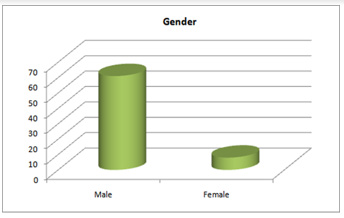
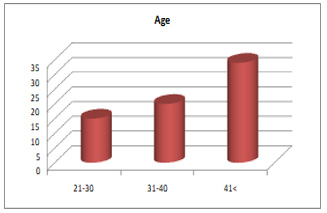
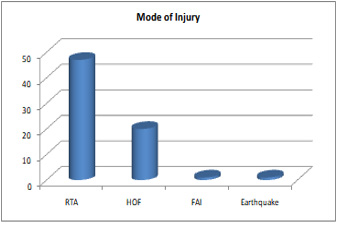
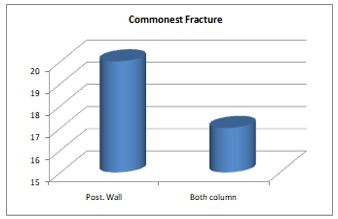
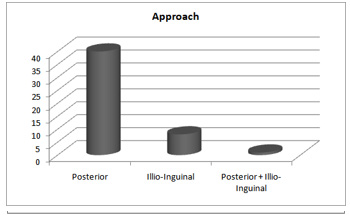
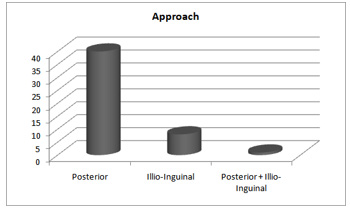
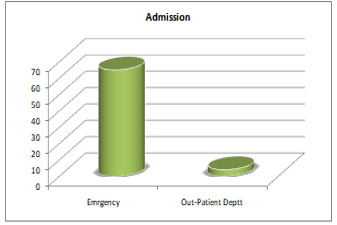
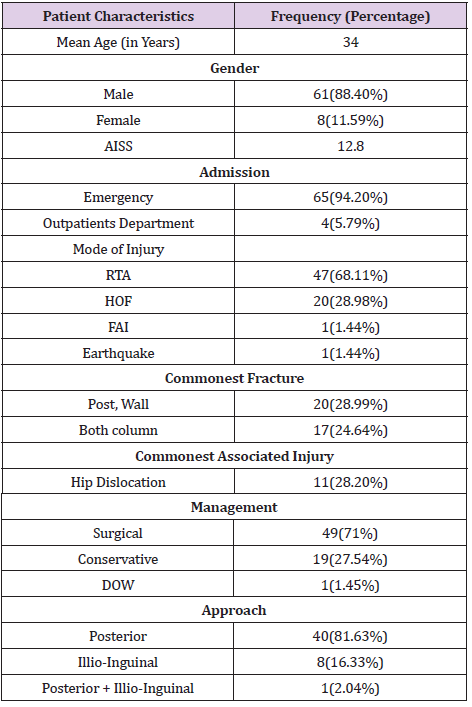


No comments:
Post a Comment
Note: Only a member of this blog may post a comment.